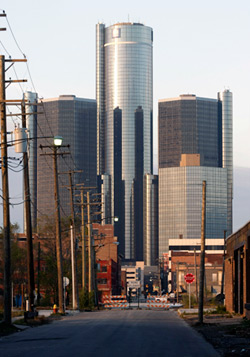The Longform.org Guide to Detroit
From the World War II boom to "ruin porn," five odes to the Motor City.

Every weekend, Longform.org shares five great stories from its archive with Slate. For a daily selection of new and classic nonfiction, check out Longform.org or follow @longformorg on Twitter.
Writers like to write about Detroit's demise. Photographers love to photograph it. The city's failings have been so thoroughly and sensationally documented, journalism critics have even given the genre a name: ruin porn. And while the tale of Detroit certainly includes its decay—Rebecca Solnit's 2007 article for Harper's is the definitive piece on the subject—these five stories hit the full arc of the Motor City: its rise, its heyday, its fall, and its future. Battle of Detroit Time • March 1942 A wartime profile of Henry Ford, with the auto industry at the height of its hyperbolic powers:
"A year ago Willow Run was a lazy little creek west of Detroit, surrounded by woodlands, a few farmhouses, a few country schools. Today Willow Run is the most enormous room in the history of man: more than a half-mile long, nearly a quarter of a mile wide. In this great room errands are run by automobile; through the flash of moving machinery and the dust of construction, no man can see from one end to the other."
It Happened in Hitsville Lisa Robinson • Vanity Fair • December 2008 An oral history of Motown Records, its founder Berry Gordy, and 1960s Detroit:
"Smokey Robinson: In Detroit you could not go into the white areas unless you proved you worked for somebody. But the kids in those areas would write us letters: 'We've got your music, we love your music, we're so glad you're making music, but our parents don't know we have it, because they'd make us get rid of it.' A year or so down the line, we're getting letters from the parents: 'Our kids turned us on to your music. We're so glad you're in business; your music is so uplifting.' "
Detroit Arcadia Rebecca Solnit • Harper's • July 2007 On wandering through the city's "post-American" landscape:
"Downtown still looks like a downtown, and all of those high-rise buildings still make an impressive skyline, but when you look closely at some of them, you can see trees growing out of the ledges and crevices, an invasive species from China known variously as the ghetto palm and the tree of heaven. Local wisdom has it that whenever a new building goes up, an older one will simply be abandoned, and the same rule applies to the blocks of new condos that have been dropped here and there among the ruins: why they were built in the first place in a city full of handsome old houses going to ruin has everything to do with the momentary whims of the real estate trade and nothing to do with the long-term survival of cities."
The Courage of Detroit Mitch Albom • Sports Illustrated • January 2009 A response to the national media's mourning:
"Enough. We're not gum on the bottom of America's shoe. We're not grime to be wiped off with a towel. Detroit and Michigan are part of the backbone of this country, the manufacturing spine, the heart of the middle class—heck, we invented the middle class, we invented the idea that a factory worker can put in 40 hours a week and actually buy a house and send a kid to college. What? You have a problem with that? You think only lawyers and hedge-fund kings deserve to live decently?"
Demolishing Detroit (in Order to Save It) Howie Kahn • GQ • May 2011 On Mayor Dave Bing's plan to demolish 10,000 abandoned homes throughout the city:
"Detroit politicians have been delivering Save Detroit sermons for as long as I can remember. (I was born there in 1978.) But there was something different about Bing's speech. The mayor talked about the city as a whole, not just the nugget of Downtown that local leaders have been cradling, coddling, and polishing since the '70s. The notion of "bringing Detroit back" has always focused on several square miles of partially occupied office buildings, luxury-boxed sports stadiums, and casinos—and on keeping solvent the city's most iconic contemporary-era building, the Renaissance Center, which looks like seven stacks of obscenely waxed tires. (It has been the headquarters of both Ford and General Motors.) Meanwhile the neighborhoods, the places where the people actually live, have been almost uniformly scrubbed from public awareness. This neglect left everywhere but Downtown withered and has long set the rest of the city up for a comeback."
Have a favorite Detroit story that we missed? Leave the link in the comments or tweet it to @ longformorg. For more writing about cities, check out Longform.org's archives on New York, Chicago, and Los Angeles.
